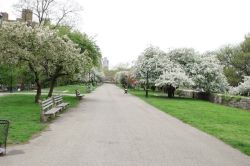Riverside Park
Ralph Ellison Plaza
What was here before?
In the mid-1800s, this hilly area of northern Manhattan was mostly rural. The expansion of the city’s grid plan and extension of public transportation and Riverside Drive created a population boom in the late 19th to early 20th century. Apartment buildings, once associated with unventilated, dark, and overcrowded tenements, were being built in New York City for middle and upper class. The landmarked Beaumont Apartments at 730 Riverside Drive, built in 1912, were designed by the architectural firm of George and Edward Blum in an Arts and Crafts style and were later home to such luminaries as author Ralph Ellison, singer Marian Anderson, and U.S. senator Jacob Javits.
How did this site become a park plaza?
Following the completion in 1900 of the steel viaduct bridging the wide ravine from 125th to 135th Streets, Riverside Park was extended northward along a narrow property abutting a steep incline to the exposed railroad tracks by the river below. As in the southern park, small landscape islands on the east side of Riverside Drive were the result of parallel side roads created to accommodate building construction along the rolling topography.
This oval shaped plaza was rebuilt in 2003 based on designs by noted landscape architect Ken Smith. The redesign intended to beautify this modest crossroads and accommodate a memorial to Ralph Ellison. Smith’s plan features flowering trees and shrubs, notably red azaleas closest to the monument, which then transition to pink and white as you get further from the monument. The landscape around the memorial is enclosed by a small red wicket fence, and biographical details and literary quotations by Ellison are engraved in several pink granite cheek walls framing the site.
Taking its inspiration from Ralph Ellison’s novel Invisible Man, the memorial by Elizabeth Catlett (1915-2012) consists of a bronze monolith 15 feet in height and ten feet wide, featuring a hollow silhouette of a striding man. It was dedicated in 2003.
Who is this plaza named for?
In 2021, as part of an NYC Parks initiative to expand the representation of African Americans honored in parks, this plaza was named for novelist, essayist and literary critic Ralph Ellison (1914-1994).
Ralph Ellison was born in Oklahoma City in 1914. After attending Tuskegee Institute, he moved to New York in 1936 and worked on the Federal Writers' Project, part of the New Deal-era Works Progress Administration. His first novel Invisible Man (1952) – in which the African-American protagonist moved to New York, became caught up in the tumultuous civil rights issues of the time and ultimately receded into “invisibility” – earned Ellison international fame and won him a National Book Award in 1953. Ellison’s novel Juneteenth was published posthumously. Later in his life he taught at New York University. Ellison died in 1994 and is buried nearby at Trinity Cemetery.
Check out your park's Vital Signs
Clean & Safe
Green & Resilient
Empowered & Engaged Users
Share your feedback or learn more about how this park is part of a
Vital Park System

Know Before You Go
Related inquiries may be sent to boatbasin@parks.nyc.gov
Related inquiries may be sent to boatbasin@parks.nyc.gov


